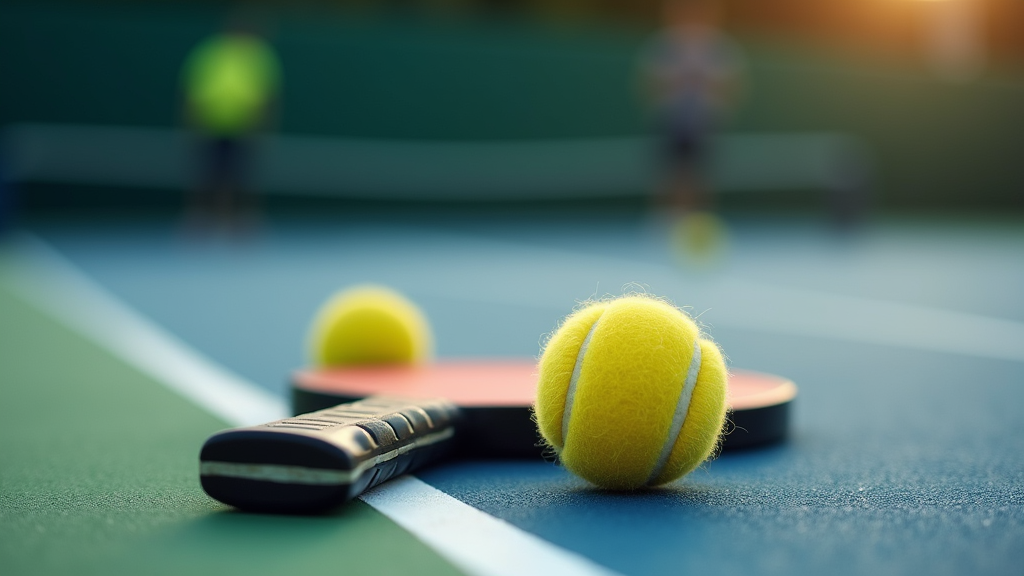Table of Contents
Introduction

Overview and Importance
Pickleball tournaments are exploding in popularity, with thousands of events taking place across the globe each year. From small local gatherings to large national championships, the competitive pickleball scene offers something for everyone. Whether you’re a seasoned pro or a recreational player looking to test your skills, participating in a tournament can be an incredibly rewarding experience. However, success and enjoyment in these events hinge on proper preparation. Rushing in unprepared can lead to frustration, injury, and underperformance. This comprehensive guide is designed to provide you with all the knowledge and tools you need to excel in your next pickleball tournament. We’ll cover every aspect of preparation, from physical and mental conditioning to gear selection and strategic gameplay.
Background
Pickleball’s rise to prominence has been nothing short of meteoric. In recent years, the sport has experienced exponential growth, attracting players of all ages and skill levels. This surge in popularity has naturally led to a corresponding increase in the number of pickleball tournaments being organized worldwide. The game itself is a unique blend of tennis, badminton, and table tennis, making it accessible and appealing to a wide range of athletes. Played on a badminton-sized court with a lowered net, pickleball utilizes a perforated plastic ball and solid paddles. Understanding the rules and regulations of tournament play is essential, and these are generally governed by USA Pickleball, the sport’s national governing body. Familiarizing yourself with their guidelines will ensure you’re ready to compete fairly and effectively.
What You’ll Learn
This guide is your one-stop resource for mastering pickleball tournament preparation. By the end of this series, you’ll have a clear understanding of how to navigate the competitive pickleball landscape and maximize your chances of success. We’ll delve into the crucial aspects of selecting the right tournament for your skill level and finding a compatible partner to complement your strengths. You’ll learn essential pickleball skills and discover effective physical conditioning strategies to enhance your agility, endurance, and power on the court. Mental preparation is just as important as physical training, so we’ll explore techniques for managing pressure, staying focused, and maintaining a positive mindset throughout the tournament. Furthermore, we’ll provide a detailed checklist of gear and supplies to pack, ensuring you’re fully equipped for any situation. Finally, we’ll analyze on-court strategies to help you outmaneuver your opponents and offer post-game recovery tips to minimize fatigue and prevent injuries.
Understanding Tournament Basics
Fundamental Concepts
Pickleball tournaments offer a fantastic way to test your skills, meet fellow enthusiasts, and experience the thrill of competitive play. Before diving in, it’s essential to grasp some fundamental concepts that underpin the tournament landscape.
One of the most important concepts is the rating system. Organizations like USAPA (USA Pickleball Association) and DUPR (Dynamic Universal Pickleball Rating) provide numerical ratings that represent a player’s skill level. These ratings typically range from 1.0 to 5.0 or higher, with higher numbers indicating greater proficiency. Your rating plays a crucial role in determining which divisions you’re eligible to enter.
Divisions are groupings of players based on their skill level and sometimes other factors like age or gender. For example, you might see divisions like “Men’s Singles 3.5,” “Women’s Doubles 4.0,” or “Mixed Doubles 4.5.” These divisions ensure that you’re competing against players of comparable ability, leading to more balanced and enjoyable matches.
Finally, understanding tournament formats is key. Common formats include round robin, single elimination, and double elimination. In a round robin format, each team or player plays every other team or player in their group. This format guarantees a certain number of matches and is often used in the initial stages of a tournament. Single elimination tournaments are straightforward: one loss, and you’re out. Double elimination tournaments offer a bit more leeway, allowing players one loss before being eliminated from the competition.
Essential Components
Beyond the fundamental concepts, several essential components contribute to the overall tournament experience. These range from the practicalities of registration to the logistics of tournament duration.
Registration is the first step in participating in a tournament. Most tournaments utilize online platforms like pickleballbrackets.com to manage registration. These platforms allow you to search for tournaments, view event details, and sign up for your desired divisions. Be sure to create an account and familiarize yourself with the platform’s features well in advance of any registration deadlines.
Tournament fees are another important consideration. The cost to enter a tournament can vary significantly, ranging from around $20 for small, local events to over $300 for major national or regional tournaments. These fees typically cover court rentals, tournament organization, and sometimes include a tournament t-shirt or other perks. Be sure to factor these costs into your tournament budget.
Tournament duration can also vary. While some divisions might be completed in a single day, larger tournaments can span three or four days. The duration depends on the number of participants, the number of divisions, and the tournament format. Keep the following aspects in mind:
- Primary aspects:Skill-based divisions, round robin or elimination formats.
- Secondary aspects:Membership requirements (e.g., USAPA), registration deadlines.
- Important variations:Local vs. national tournaments, singles vs. doubles.
Understanding these factors will help you plan your schedule and make the most of your tournament experience.
Detailed Guide

Tournament Selection and Partner Selection
Choosing the right tournament and partner are crucial first steps towards a successful pickleball experience. Thoughtful decisions here can significantly impact your enjoyment and performance.
Selecting the right tournament involves several considerations. Start with <strong>location</strong>: opt for a tournament within a reasonable driving distance or one easily accessible by flight to minimize travel stress. Next, consider the <strong>date</strong>. Ensure the tournament dates align with your availability and, importantly, with your training schedule. You’ll want adequate time to prepare. Finally, and perhaps most critically, evaluate the <strong>competition level</strong>. Choose a division that appropriately matches your USAPA or DUPR rating. Playing against opponents who are significantly above or below your skill level can be frustrating and unproductive.
In doubles, your partner is your ally. Look for someone whose strengths <strong>complement your weaknesses</strong>. For example, if you excel at dinking but struggle with power shots, seek a partner with a strong overhead game. <strong>Playing style compatibility</strong> is also essential. Choose a partner whose overall approach to the game meshes well with yours. And, of course, personality matters. Finally, prioritize <strong>communication</strong>. Effective on-court communication is paramount. You and your partner should be able to clearly and calmly discuss strategy, call shots, and provide encouragement.
Game Preparation
Proper preparation is the cornerstone of a successful tournament. This includes skill improvement, physical conditioning, and adopting a healthy lifestyle.
Focus on honing your pickleball skills through targeted practice. <strong>Drilling</strong> specific techniques, such as forehands, backhands, serves, and volleys, is essential. Repetition builds consistency. Develop <strong>strategic shots</strong> and learn to recognize and capitalize on various match scenarios. Practice playing in <strong>pressure situations</strong> to build confidence and composure under stress. Simulate tournament conditions during your practice sessions.
Pickleball demands physical stamina and agility. Enhance your <strong>cardiovascular fitness</strong> through activities like jogging, cycling, or swimming. Incorporate <strong>flexibility</strong> exercises to prevent injuries and improve your range of motion. Perform stretches before and after each practice session. Engage in <strong>agility drills</strong>, such as ladder exercises and cone sprints, to improve your footwork and reaction time.
Fuel your body for peak performance with a <strong>balanced diet</strong> rich in carbohydrates, proteins, and healthy fats. Stay well-<strong>hydrated</strong>, especially during training and tournaments. Dehydration can significantly impair your performance. Prioritize getting adequate <strong>sleep</strong> to allow your body to recover and rebuild. Aim for 7-9 hours of quality sleep each night.
Packing Your Bag
Packing efficiently ensures you have everything you need on tournament day. Don’t leave anything to chance!
Always bring your <strong>paddles</strong>, including a backup in case your primary paddle breaks or becomes damaged. Pack several <strong>pickleballs</strong> that are USAPA-approved for tournament play. Ensure you have the right <strong>shoes</strong>. Wear appropriate athletic shoes designed for court surfaces to provide support and prevent injuries.
Bring a <strong>water bottle</strong> that you can refill throughout the day. Pack <strong>electrolyte</strong> tablets or drinks to replenish lost minerals. Don’t forget <strong>snacks</strong> like energy bars, granola, nuts, or protein bars for sustained energy.
Protect yourself from the sun with <strong>sunglasses or eyewear</strong>. Wear a <strong>hat</strong> with a wide brim or a visor to shield your face. Apply <strong>sunscreen</strong> with an SPF of 30 or higher to all exposed skin.
Bring a small <strong>towel</strong> for wiping away sweat. Use <strong>sweatbands</strong> on your head and wrists to keep sweat out of your eyes and off your grip. Pack an <strong>extra shirt and socks</strong> to change into if needed. Don’t forget travel-sized <strong>deodorant</strong>.
A portable <strong>folding chair</strong> can provide a comfortable place to rest between matches. Consider bringing a <strong>sun umbrella</strong> for shade, especially at outdoor tournaments.
Carry your <strong>identification</strong>, such as a driver’s license. Bring your <strong>cell phone</strong> for communication. Have a <strong>credit card</strong> for any purchases you may need to make.
Pack a small <strong>first aid kit</strong> with band-aids, pain relievers, and pain gel for minor injuries.
Day of the Event
A well-planned day will help you perform your best and stay comfortable throughout the tournament.
<strong>Arrive early</strong>, at least one hour before your first match, to allow ample time for registration and warm-up. Complete <strong>registration</strong> and check-in procedures promptly. Perform a structured <strong>warm-up routine</strong> with stretches and dynamic movements to prepare your body for play.
Use <strong>visualization</strong> techniques to mentally prepare for your match. Practice <strong>mindfulness</strong> to stay calm and focused on the present moment.
Coordinate your <strong>strategy</strong> with your partner before the match. Be <strong>adaptable</strong> and willing to adjust your strategies based on observations of your opponents. Focus on playing your best and <strong>stick to the basics</strong> you’ve practiced.
<strong>Stay hydrated</strong> by drinking water and electrolytes throughout the day. <strong>Refuel</strong> with snacks to maintain your energy levels.
Find a place to <strong>rest and refuel</strong> between matches. Keep your muscles loose with light stretching or foam rolling to <strong>stay active</strong>.
Mental Preparation
Mental fortitude is as important as physical skill. Cultivate a strong and resilient mindset.
Maintain a <strong>positive attitude</strong> and be your own cheerleader. Manage the inevitable highs and lows throughout the day with a <strong>balanced mindset</strong>. Remember to <strong>enjoy</strong> the tournament experience, both the competition and the camaraderie.
Practice deep <strong>breathing exercises</strong> to stay calm and focused under pressure. Use <strong>visualization</strong> to picture successful plays and outcomes.
Post-Tournament Recovery
Proper recovery is crucial for preventing injuries and preparing for future tournaments.
<strong>Rehydrate</strong> with water and electrolytes to replenish fluids. Perform static <strong>stretches</strong> to reduce muscle soreness. Use a <strong>foam roller</strong> to release muscle tension. Consider using <strong>percussive massage devices</strong> for enhanced muscle recovery.
Reflect on your performance to identify areas for improvement in a <strong>performance review</strong>. <strong>Track your progress</strong> and set goals for future tournaments to maintain motivation and focus.
Advanced Techniques
Elevate your game with advanced strategies and a commitment to continuous improvement.
<strong>Observe your opponents</strong> play to identify their strengths and weaknesses. <strong>Adapt your strategy</strong> based on your observations to exploit their weaknesses and neutralize their strengths.
<strong>Practice regularly</strong> to maintain and improve your skills. Participate in future tournaments to gain experience and test your abilities. Share your experiences with others to maintain <strong>community engagement</strong> and learn collectively.
Conclusion
Summary of Key Points
As we’ve explored, excelling in pickleball tournaments demands more than just a love for the game. It requires diligent preparation across multiple fronts. Remember, preparation is the cornerstone of success in any competitive endeavor, and pickleball is no exception.
We’ve emphasized the importance of physical and mental conditioning. Building your stamina, agility, and mental fortitude are crucial for enduring the demands of tournament play. Your gear also plays a significant role; having the right paddle, shoes, and apparel can significantly impact your performance and comfort. Developing a solid strategy, understanding your strengths and weaknesses, and adapting to your opponents are essential for gaining a competitive edge. And finally, don’t underestimate the power of recovery. Proper rest, nutrition, and post-match routines are vital for preventing injuries and ensuring you’re at your best for each match.
By diligently incorporating these elements into your training and tournament approach, you’ll be well-equipped to navigate the challenges of competitive pickleball. Following the tips and advice outlined in this guide can significantly improve your chances of success, allowing you to perform at your peak and fully enjoy your tournament experience.
Final Thoughts
Pickleball tournaments offer a fantastic opportunity to test your skills against other passionate players, forge new friendships, and immerse yourself in the vibrant pickleball community. They’re a chance to push your limits, learn from others, and celebrate the joy of the game.
Ultimately, the goal is to have fun and enjoy the experience. While winning is certainly a rewarding outcome, remember that the journey of improvement and the camaraderie you share with fellow players are equally valuable. With proper preparation, a positive attitude, and a focus on continuous learning, you can maximize your enjoyment of pickleball tournaments and achieve your personal goals, whether they involve climbing the ranks or simply having a great time on the court.

